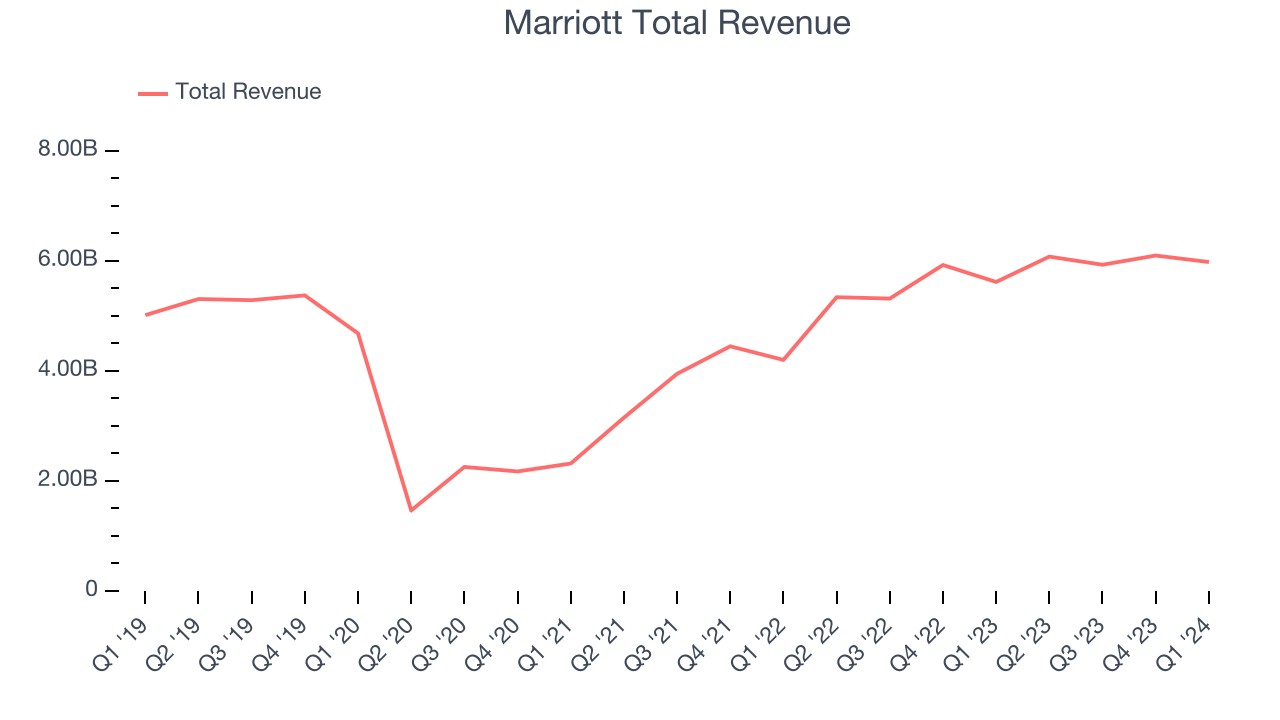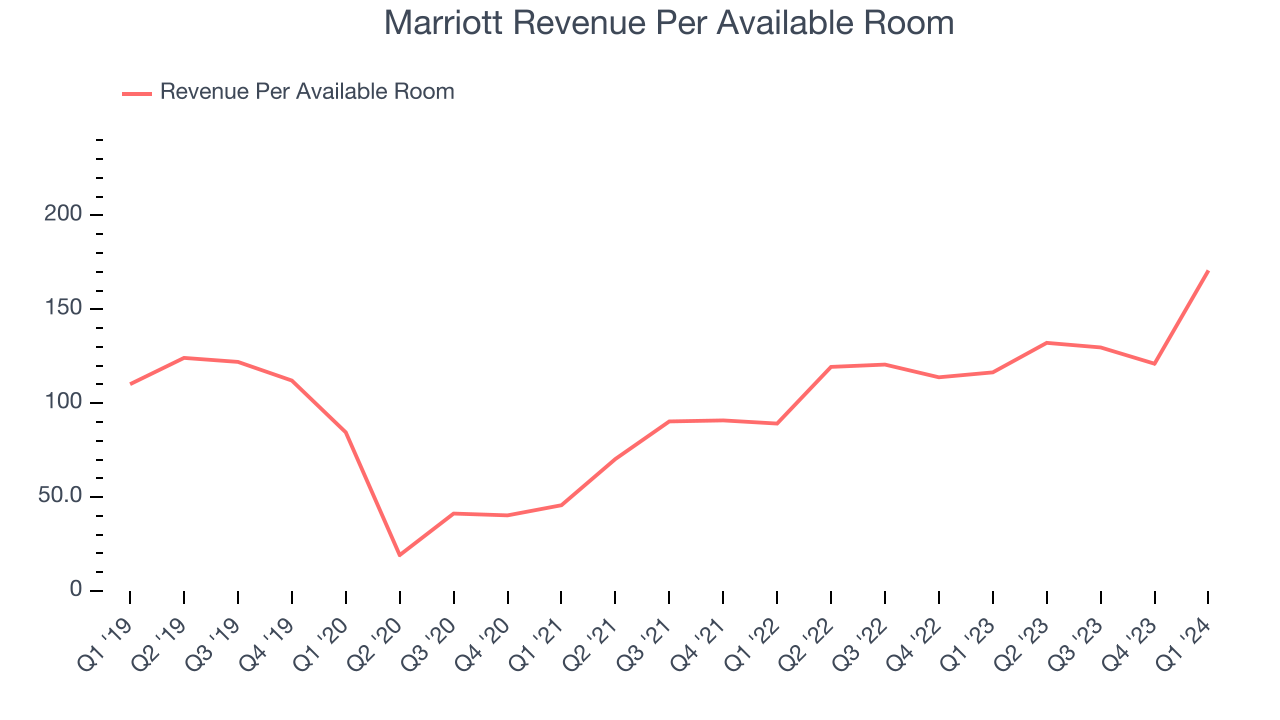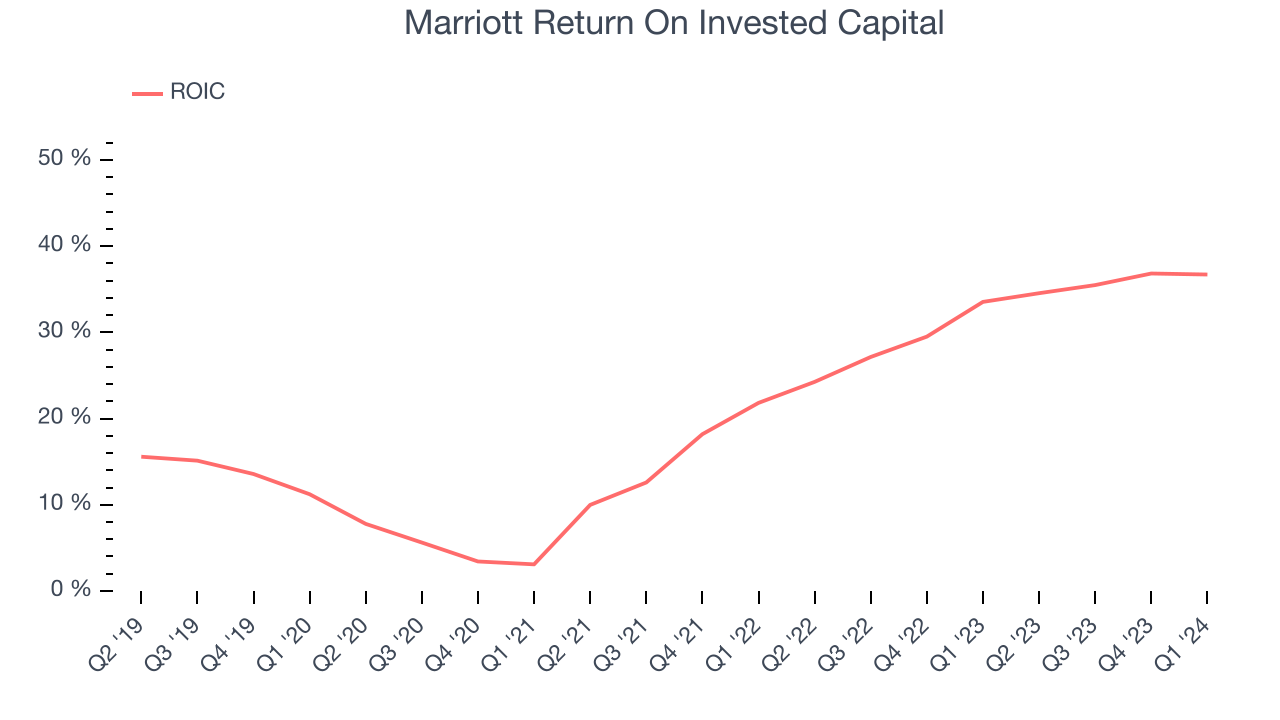Global hospitality company Marriott (NASDAQ:MAR) reported results in line with analysts' expectations in Q1 CY2024, with revenue up 6.4% year on year to $5.98 billion. It made a non-GAAP profit of $2.13 per share, improving from its profit of $2.08 per share in the same quarter last year.
Marriott (MAR) Q1 CY2024 Highlights:
- Revenue: $5.98 billion vs analyst estimates of $5.95 billion (small beat)
- EPS (non-GAAP): $2.13 vs analyst expectations of $2.16 (1.6% miss)
- EPS (non-GAAP) Guidance for Q2 CY2024 is $2.46 at the midpoint, below analyst estimates of $2.51
- EPS (non-GAAP) Guidance for full year 2024 is $9.48 at the midpoint, above analyst estimates of $9.44
- Gross Margin (GAAP): 95.2%, in line with the same quarter last year
- Market Capitalization: $68.07 billion
Founded by J. Willard Marriott in 1927, Marriott International (NASDAQ:MAR) is a global hospitality company with a portfolio of over 7,000 properties and 30 brands, spanning 130+ countries and territories.
Marriott’s global presence is divided among 30+ hotel brands, catering to a wide range of traveler needs, preferences, and budgets. At the luxury end, Marriott offers iconic brands like The Ritz-Carlton, St. Regis, and JW Marriott. In the premium segment, brands like Marriott Hotels, Sheraton, and Renaissance Hotels provide sophisticated and thoughtful amenities for business and leisure travelers. Additionally, the company's select-service brands, such as Courtyard, Fairfield by Marriott, and Moxy Hotels, offer more affordable options for those who want convenience and cleanliness without breaking the bank.
Because the company operates in a competitive industry, personalized guest experiences are central to Marriott's customer acquisition and retention efforts. At the heart of this is the Marriott Bonvoy loyalty program that digitizes much of the guest experience for maximum convenience and offers perks such as upgrades, member-exclusive rates, and points that can be redeemed for meals and services.
Marriott's go-to-market and growth strategy includes a mix of franchised and owned-and-operated properties. This mix results in advantages such as an asset-light model (since franchise partners assume much of the investment costs) and more flexibility to expand in certain geographies with partners who know their locales best.
Hotels, Resorts and Cruise Lines
Hotels, resorts, and cruise line companies often sell experiences rather than tangible products, and in the last decade-plus, consumers have slowly shifted from buying "things" (wasteful) to buying "experiences" (memorable). In addition, the internet has introduced new ways of approaching leisure and lodging such as booking homes and longer-term accommodations. Traditional hotel, resorts, and cruise line companies must innovate to stay relevant in a market rife with innovation.
Marriott International's primary competitors include Hilton Worldwide (NYSE:HLT), InterContinental Hotels Group (NYSE:IHG), Hyatt Hotels (NYSE:H), Wyndham Hotels & Resorts (NYSE:WH), and Accor (EPA:AC).Sales Growth
A company’s long-term performance can give signals about its business quality. Even a bad business can shine for one or two quarters, but a top-tier one may grow for years. Marriott's annualized revenue growth rate of 3% over the last five years was weak for a consumer discretionary business.  Within consumer discretionary, a long-term historical view may miss a company riding a successful new property or emerging trend. That's why we also follow short-term performance. Marriott's annualized revenue growth of 23.7% over the last two years is above its five-year trend, suggesting some bright spots.
Within consumer discretionary, a long-term historical view may miss a company riding a successful new property or emerging trend. That's why we also follow short-term performance. Marriott's annualized revenue growth of 23.7% over the last two years is above its five-year trend, suggesting some bright spots.
We can dig even further into the company's revenue dynamics by analyzing its revenue per available room, which clocked in at $170.75 this quarter and is a key metric accounting for average daily rates and occupancy levels. Over the last two years, Marriott's revenue per room averaged 28.8% year-on-year growth. Because this number is higher than its revenue growth, we can see its room bookings outperformed its sales from other areas like restaurants, bars, and amenities. 
This quarter, Marriott grew its revenue by 6.4% year on year, and its $5.98 billion of revenue was in line with Wall Street's estimates. Looking ahead, Wall Street expects sales to grow 7.2% over the next 12 months, an acceleration from this quarter.
Operating Margin
Operating margin is an important measure of profitability. It’s the portion of revenue left after accounting for all core expenses–everything from the cost of goods sold to advertising and wages. Operating margin is also useful for comparing profitability across companies with different levels of debt and tax rates because it excludes interest and taxes.
Marriott has been a well-managed company over the last eight quarters. It's demonstrated it can be one of the more profitable businesses in the consumer discretionary sector, boasting an average operating margin of 16.5%.This quarter, Marriott generated an operating profit margin of 14.7%, down 2.3 percentage points year on year.
Over the next 12 months, Wall Street expects Marriott to become more profitable. Analysts are expecting the company’s LTM operating margin of 15.7% to rise to 16.7%.EPS
We track long-term historical earnings per share (EPS) growth for the same reason as long-term revenue growth. Compared to revenue, however, EPS highlights whether a company's growth was profitable.
Over the last five years, Marriott's EPS grew 60.4%, translating into an unimpressive 9.9% compounded annual growth rate. This performance, however, is materially higher than its 3% annualized revenue growth over the same period. There are a few reasons for this, and understanding why can shed light on its fundamentals.
While we mentioned earlier that Marriott's operating margin declined this quarter, a five-year view shows its margin has expanded 4.5 percentage points while its share count has shrunk 14.9%. Improving profitability and share buybacks are positive signs as they juice EPS growth relative to revenue growth.In Q1, Marriott reported EPS at $2.13, up from $2.08 in the same quarter last year. Despite growing year on year, this print unfortunately missed analysts' estimates. Over the next 12 months, Wall Street expects Marriott to perform poorly. Analysts are projecting its LTM EPS of $10.07 to shrink by 3.7% to $9.70.
Return on Invested Capital (ROIC)
EPS and free cash flow tell us whether a company was profitable while growing revenue. But was it capital-efficient? A company’s ROIC explains this by showing how much operating profit a company makes compared to how much money the business raised (debt and equity).
Marriott's five-year average return on invested capital was 21.3%, beating other consumer discretionary companies by a wide margin. Just as you’d like your investment dollars to generate returns, Marriott's invested capital has produced robust profits.

The trend in its ROIC, however, is often what surprises the market and drives the stock price. Over the last few years, Marriott's ROIC has significantly increased. This is a good sign, and if the company's returns keep rising, there's a chance it could evolve into an investable business.
Balance Sheet Risk
As long-term investors, the risk we care most about is the permanent loss of capital. This can happen when a company goes bankrupt or raises money from a disadvantaged position and is separate from short-term stock price volatility, which we are much less bothered by.
Marriott reported $400 million of cash and $12.7 billion of debt on its balance sheet in the most recent quarter. As investors in high-quality companies, we primarily focus on two things: 1) that a company's debt level isn't too high and 2) that its interest payments are not excessively burdening the business.
With $4.7 billion of EBITDA over the last 12 months, we view Marriott's 2.6x net-debt-to-EBITDA ratio as safe. We also see its $575 million of annual interest expenses as appropriate. The company's profits give it plenty of breathing room, allowing it to continue investing in new initiatives.
Key Takeaways from Marriott's Q1 Results
Marriott's operating margin missed and its EPS fell short of Wall Street's estimates. Next quarter's EPS guidance missed expectations as well, although one positive is that full year gross fee revenue was raised from previous and full year EPS guidance slightly exceeded Wall Street's estimates. Overall, this was a mixed quarter for Marriott. The company is down 1.5% on the results and currently trades at $232.52 per share.
Is Now The Time?
When considering an investment in Marriott, investors should take into account its valuation and business qualities as well as what's happened in the latest quarter.
We have other favorites, but we understand the arguments that Marriott isn't a bad business. Although its revenue growth has been weak over the last five years, its growth over the next 12 months is expected to be higher. And while its projected EPS for the next year is lacking, its revenue per room has surged over the last two years.
Marriott's price-to-earnings ratio based on the next 12 months is 24.3x. There are things to like about Marriott and there's no doubt it's a bit of a market darling, at least for some investors. But it seems there's a lot of optimism already priced in and we wonder if there are better opportunities elsewhere right now.
Wall Street analysts covering the company had a one-year price target of $246.33 per share right before these results (compared to the current share price of $232.52).
To get the best start with StockStory, check out our most recent stock picks, and then sign up for our earnings alerts by adding companies to your watchlist here. We typically have the quarterly earnings results analyzed within seconds of the data being released, and especially for companies reporting pre-market, this often gives investors the chance to react to the results before the market has fully absorbed the information.
